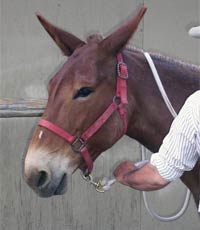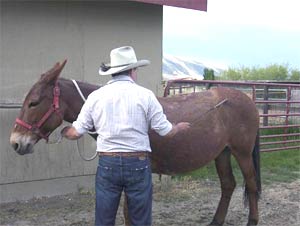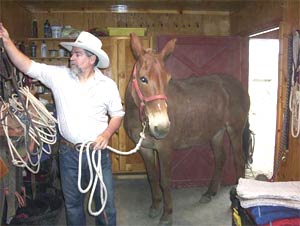Training starts with an exercise as basic as moving forward.
Teaching your mule the “go forward” cue is essential to everything
he does. It is essential to walking, side-passing, loping, trotting,
trailer loading, leading, crossing water, leaving a group on a trail
ride to ride alone, jumping, moving cattle, barrel racing… and the
list goes on.
Once your mule understands the cue to move forward, then you can
teach him any maneuver with the reins and your legs. But if your
mule ever locks his feet or is reluctant to move then you are
missing this essential step in your training.
Has your mule ever refused to move when you ride or lead him? Do you
ever find yourself constantly kicking your mule to get him to walk
forward? The “go forward” cue is the answer.
You ride the mule you lead
|
 |
|
Hold the rope or rein
six inches from the halter or bridle. |
Many people don’t think leading and ground manners are important.
They think that it is OK for their mule to have bad ground and
leading manners, as long as he is fine under saddle.
However, if there are “holes” in your mule’s leading and ground
manners, then there will be “holes” when you are riding your mule
and in his overall training. Period.
Many people will bring me a mule with riding problems. The mule will
buck, run off, lock-up his feet, won't respond to the bridle, etc.
In every case, I can see the problem when the owner is handling the
mule on the ground. Most of the time, the problem can be fixed on
the ground before I even get on the mule. I will never ride a mule
that has bad ground manners.
"Go forward" cue
This is why the “go forward” cue is essential to your mule’s
training. If this is not solid, then everything else will have
holes. Your mule should go forward when you ask him to. It should
not matter if you are asking him to walk, trot or run next to you on
the ground. It also should not matter that you are moving through
the pasture, walking into the trailer or running across a tarp.
To teach the “Go Forward” cue, you will concentrate on the point of
the hip. If you get the hip to move forward, the rest of the mule
will follow.
For this lesson, you will need a halter and lead rope or a bridle
with a snaffle bit and a stiff dressage whip.
|
 |
|
When teaching the "go
forward" cue, tap the point of the hip, as shown here, to
ask the mule to move forward |
With the halter or bridle on the mule, stand off to the side of the
mule at the shoulder. Place the free end of the lead rope over the
mule’s neck. Hold the lead rope about six inches from the halter or
bit. Look at the point of the hip. Looking at the point of the hip
is your first cue. This is called a “pre-cue.”
If the mule does not move forward, kiss or cluck to your mule. This
is your second “pre-cue.” The next cue is to take the dressage whip
and gently tap the mules “point of the hip.” We want to encourage
the mule to move forward, not beat or hurt the mule. We do not want
the mule to feel any pain. Pain will only cause resistance in the
mule. You want the mule to know that you will keep tapping until he
moves forward.
The second the mule moves a foot forward, immediately stop the
tapping and praise the mule. If the mule does not respond, tap a
little harder. But be sure to stop tapping the minute the mule moves
forward, even if for just one step.
It is important to stop the cue and praise the mule. This tells the
mule he gave you the right answer. It will get the mule to try
harder to find the right answer.
Be sure to understand how your mule thinks. He may try to move
backward, left or right, or up or down before he tries moving
forward. This is how he finds the right answer. Your mule can move
in six different directions; up, down, left, right, forward or
backward. When he finds the answer you are looking for, then you
praise him. As you continue to reinforce the cue and continue
asking, he will learn exactly what you are looking for and begin
getting the answer sooner and sooner.
An immediate release will get your mule to respond quicker and try
harder. After much practice, the mule will start to respond from
your pre- ues. You will be able to teach your mule to “go forward”
by looking at the point of the hip and kissing to the mule.
After the mule responds to your cue and you have praised him, ask
the mule to “go forward” again. Go through your pre-cues and cues
until the mule moves forward.
Work on getting your mule to constantly take one step forward. Then,
after he is consistent with one step, begin asking the mule for two
steps, then three and four and so on. By now your mule should be
responding to your pre-cues, but be patient, this will take many
repetitions.
You may be thinking, “How will this help me in the saddle?” When
riding, you will use the same formula, but with your legs.
Understand that this will translate to the saddle. Your mule will
begin associating what you are asking with what you did on the
ground and he will get the right answer quicker and more
consistently.
While in the saddle, if your mule stops moving forward, concentrate
on the point of the hip, then kiss or cluck to the mule. These are
your “pre-cues.” A kiss or cluck tells the mule you want “movement.”
You are asking the mule to move something.
Squeeze with your legs if the mule does not move forward. If he does
not respond to a squeeze, you will start lightly bumping the mule’s
side with your legs. Finally, you bump harder until the mule moves
forward.
Just like when you were on the ground, the second the mule moves
forward, stop the cue and praise the mule. If the mule is moving
forward, leave your legs still.
 |
|
TIM DOUD has used the "go forward" cue to teach Diamond Creek
Angel to follow him anywhere,
including the tack room. |
However, understand that if you keep bumping the mule with
your legs as he is moving, the mule will start ignoring your
cues. This is called “burning the cue.” If you keep cueing your
mule after he is doing what you’ve asked, then he will say,
“Well, he keeps kicking me when I am not moving and when I am
moving, so I guess it doesn’t matter what I do, so I will just
stop moving.” Then, your cue is burned out
Just like on the ground, If you are consistence with your cues, your
mule will start to respond from your cue, then from your pre-cues.
So, if you are leading your mule and he stops and will not move his
feet, go back to his shoulder and ask his hip to move forward. You
now have a cue to give your mule to step into the trailer, walk up
to the wash rack or cross a tarp, cross the river, and move forward.
You will be amazed at how your mule will follow you any where.
Tim can be reached at
www.diamondcreekmules.com, or by phone at 307/899-1089, or
email:
bliss@wavecom.net.
|